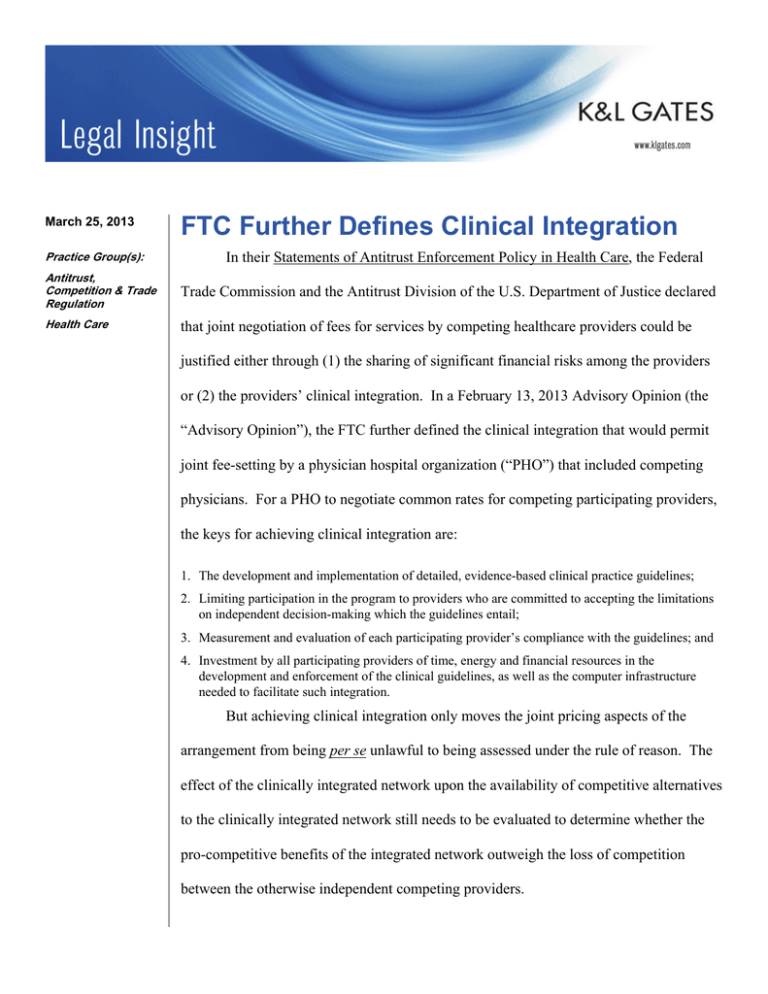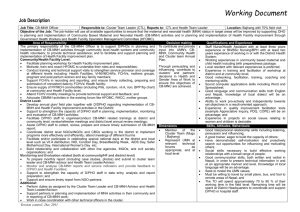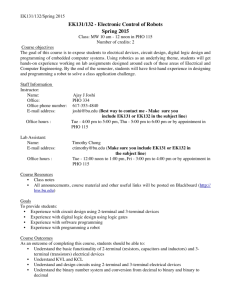FTC Further Defines Clinical Integration
advertisement

March 25, 2013 Practice Group(s): FTC Further Defines Clinical Integration In their Statements of Antitrust Enforcement Policy in Health Care, the Federal Antitrust, Competition & Trade Regulation Trade Commission and the Antitrust Division of the U.S. Department of Justice declared Health Care that joint negotiation of fees for services by competing healthcare providers could be justified either through (1) the sharing of significant financial risks among the providers or (2) the providers’ clinical integration. In a February 13, 2013 Advisory Opinion (the “Advisory Opinion”), the FTC further defined the clinical integration that would permit joint fee-setting by a physician hospital organization (“PHO”) that included competing physicians. For a PHO to negotiate common rates for competing participating providers, the keys for achieving clinical integration are: 1. The development and implementation of detailed, evidence-based clinical practice guidelines; 2. Limiting participation in the program to providers who are committed to accepting the limitations on independent decision-making which the guidelines entail; 3. Measurement and evaluation of each participating provider’s compliance with the guidelines; and 4. Investment by all participating providers of time, energy and financial resources in the development and enforcement of the clinical guidelines, as well as the computer infrastructure needed to facilitate such integration. But achieving clinical integration only moves the joint pricing aspects of the arrangement from being per se unlawful to being assessed under the rule of reason. The effect of the clinically integrated network upon the availability of competitive alternatives to the clinically integrated network still needs to be evaluated to determine whether the pro-competitive benefits of the integrated network outweigh the loss of competition between the otherwise independent competing providers. FTC Further Defines Clinical Integration Legal Background Agreements among competing providers (like independent physicians or physician groups in the same specialty) to jointly negotiate fees or reimbursements with a payor ordinarily violate Section 1 of the Sherman Act, which prohibits “agreements . . . in restraint of trade.” Under Section 1, there are two standards for measuring whether an agreement unlawfully restrains trade: (1) the rule of reason and (2) the rule of per se illegality. Under the rule of reason, the pro-competitive and anti-competitive effects of an agreement are weighed against one another to determine, on balance, whether the agreement injures or benefits the consuming public, after considering the environment of that particular industry and the product or service. By contrast, under the per se rule certain types of agreements are so injurious to competition that they are condemned as illegal without a complicated weighing and balancing. Any agreement among competing sellers of a service (including competing physicians or other healthcare providers) to jointly set fees is ordinarily per se unlawful. However, where competing providers agree to share substantial financial risk as part of their arrangement with a payor (such as by providing all required services for a capitated payment or a fixed share of premiums), joint negotiation of the fees by the participating physicians is exempt from the per se rule because the fee-setting is only a secondary aspect of the risk-shifting arrangement with the payor. Under these limited conditions, the joint negotiation of fees is subject only to the rule of reason and is legal so long as the overall arrangement is reasonably expected to benefit payors and therefore healthcare consumers. 2 FTC Further Defines Clinical Integration Similarly, joint fee negotiations by competing providers are exempt from the per se rule of illegality, if the joint fee negotiations are ancillary to a sufficient degree of clinical integration among the providers. The February 13, 2013 Advisory Opinion describes one example of sufficient clinical integration. Clinical Integration The Advisory Opinion concerns a Norman, Oklahoma, PHO involving a single hospital system and both its independent and hospital-employed physicians. The PHO is composed of multiple hospitals under common ownership and a physicians association that includes hospital-employed as well as independent physicians in 38 specialties. The hospital system and the physicians association share equally in funding the PHO’s costs of operations and its ongoing capital needs through (i) provider membership fees and dues; (ii) percentage-withholding from reimbursements paid to participating physicians by payors that contract with the network; (iii) dollar-for-dollar matching contributions from the hospital system; and (iv) monthly access fees paid directly from regional employers. The board of managers of the PHO includes three representatives of the hospital system and eight representatives of the physicians association. The clinically integrated PHO is replacing a messenger-model PHO in which each provider could separately opt in or opt out of each agreement between the PHO and a particular payor. Under the new arrangement, all members will participate in servicing any payor who contracts with the network. However, the PHO will be non-exclusive, 3 FTC Further Defines Clinical Integration and any payor that is not interested in contracting with the PHO will be free to contract separately with any of the member providers or with alternative networks in which some of the members may participate. The PHO may not discourage member participation in such alternatives to the PHO. The physicians of the PHO will establish clinical practice guidelines for as many as 50 disease-specific conditions. The guidelines will focus on common, high-cost and high-risk chronic conditions. Provider agreements with the PHO will obligate each physician to participate in the development of the network’s clinical guidelines and to adhere to the PHO’s guidelines in treating their patients. A Mentors Committee made up of participating physicians will approve the clinical practice guidelines and oversee their implementation and enforcement. A Quality Assurance Committee will develop measures to identify (i) high cost providers, (ii) inappropriate use of resources and (iii) failures to comply with the guidelines. Its activities will include auditing medical records and generating regular reports on individual and aggregate physician compliance with the guidelines and on individual and group performance bench-marking. Such compliance reports will be shared with the participating physicians and with payors. Additionally, the Quality Assurance Committee will arrange for medical education to promote compliance with the guidelines. Finally, the Quality Assurance Committee will implement corrective actions when non-compliance or risk concerns are identified, including physician-to-physician mentoring, other counseling and educational activities, financial withholds and penalties, as well as expulsion from the PHO. 4 FTC Further Defines Clinical Integration An electronic medical information platform will provide critical support for the guidelines system, including (i) an electronic clinical decisions support system; (ii) eprescribing; (iii) an electronic medical records system and (iv) an electronic health interface system. All physicians participating in the network must commit to making the clinical integration program work. Each must commit to adhere to the relevant guidelines and devote substantial time to serving on the physician committees that will develop the clinical guidelines, conduct peer counseling and implement corrective action plans. Participating physicians will be required both (i) to acquire and maintain the necessary computer equipment and software to connect with the PHO’s electronic system and (ii) to make practice data available for developing and enforcing the clinical guidelines. Each physician must also pay the membership fees and incur the holdbacks necessary to share the expenses necessary to operate the system. Anticipated Effects of the Clinically Integrated Network The PHO’s clinically integrated network is expected to generate significant efficiencies in the provision of health care services, to improve the quality of care and to increase the level of patient satisfaction. Providers will benefit from reduced paperwork, easier scheduling and improved patient diagnosis. Anticipated patient benefits include improved outcomes, better adherence to preventive screenings, fewer medical errors, lower infection rates, shorter hospital stays, lower re-admission rates and elimination of unnecessary duplication of tests. Payor benefits include centralized credentialing and contracting, higher patient satisfaction, elimination of unnecessary duplication of 5 FTC Further Defines Clinical Integration services, lower incidence of hospitalization with earlier detection of disease, fewer medical errors, lower infection rates, fewer re-admissions, decreased length of stays and lower cost of care. Although the magnitude of the projected efficiency gains cannot be quantified, the prospect for such gains by the integrated system is sufficient for the FTC to exempt the system from per se illegality and evaluate it under the rule of reason. The FTC’s conclusion that the joint negotiation of rates is reasonably necessary to the operation of the clinically integrated PHO emphasized that the joint contracting with payors is necessary to enable the clinically integrated PHO, unlike the preceding messenger-model PHO, to maintain a single, consistent panel of participating physicians with a commitment to the PHO’s clinical integration. Absent joint contracting, the makeup of the physicians willing to contract with each payor would depend upon the rates the payor was willing to pay. And such variations in the composition of the physicians participating in each agreement would disrupt the development and implementation of the integration program. Physicians bound to participate in all of the PHO’s contracts can more reasonably be expected to contribute their time, effort and money to the integration efforts. Competitive Environment The service area of the PHO consists of a portion of the Oklahoma City metropolitan area, which encompasses seven counties. The PHO’s service area is limited to four of the seven counties, plus two others outside the metro area. All of the participating hospitals are located in Cleveland county. The physicians’ offices and clinics and the family medical centers are concentrated in six cities in two counties. 6 FTC Further Defines Clinical Integration Similarly, the PHO’s patients are highly concentrated in two counties. In the sevencounty area, the PHO includes 10% of the available physicians and 10% of the available hospitals. However, within the counties where the PHO’s facilities are located, the PHO’s hospitals account for more than 50% of the patient discharges. Moreover, the PHO includes most of the physicians who practice in and around the city of Norman, and the only hospitals in the immediate Norman area. Notwithstanding the PHO’s significant concentration in and around Norman, the FTC concluded that joint rate-setting by the PHO would not be anti-competitive because of the non-exclusive nature of the PHO. Any payor that is unhappy with the PHO’s rates can deal directly with any or all of the member providers or with any other network in which some or all of the providers participate. Authors: Thomas A. Donovan thomas.donovan@klgates.com +1.412.355.6466 Anchorage Austin Beijing Berlin Boston Brisbane Brussels Charleston Charlotte Chicago Dallas Doha Dubai Fort Worth Frankfurt Harrisburg Hong Kong Houston London Los Angeles Melbourne Miami Milan Moscow Newark New York Orange County Palo Alto Paris Perth Pittsburgh Portland Raleigh Research Triangle Park San Diego San Francisco São Paulo Seattle Seoul Shanghai Singapore Spokane Sydney Taipei Tokyo Warsaw Washington, D.C. K&L Gates practices out of 47 fully integrated offices located in the United States, Asia, Australia, Europe, the Middle East and South America and represents leading global corporations, growth and middle-market companies, capital markets participants and entrepreneurs in every major industry group as well as public sector entities, educational institutions, philanthropic organizations and individuals. For more information about K&L Gates or its locations, practices and registrations, visit www.klgates.com. This publication is for informational purposes and does not contain or convey legal advice. The information herein should not be used or relied upon in regard to any particular facts or circumstances without first consulting a lawyer. ©2013 K&L Gates LLP. All Rights Reserved. 7






